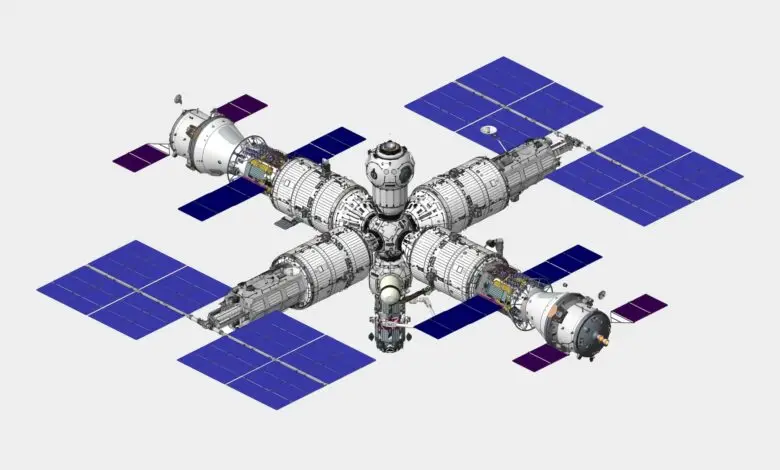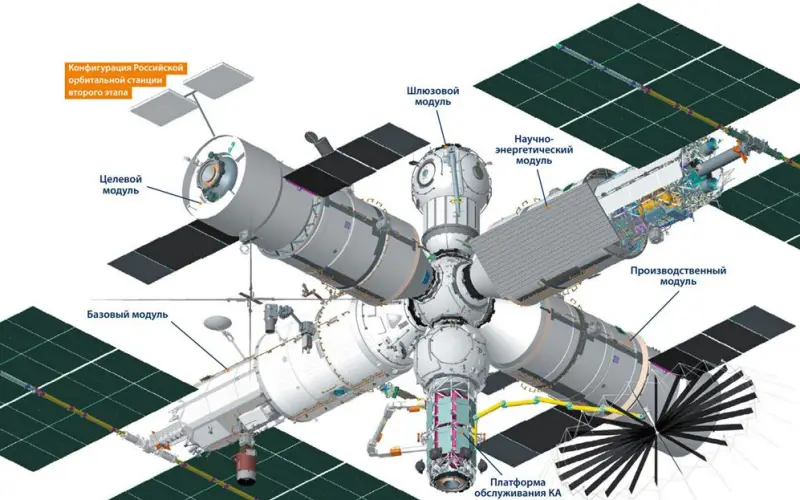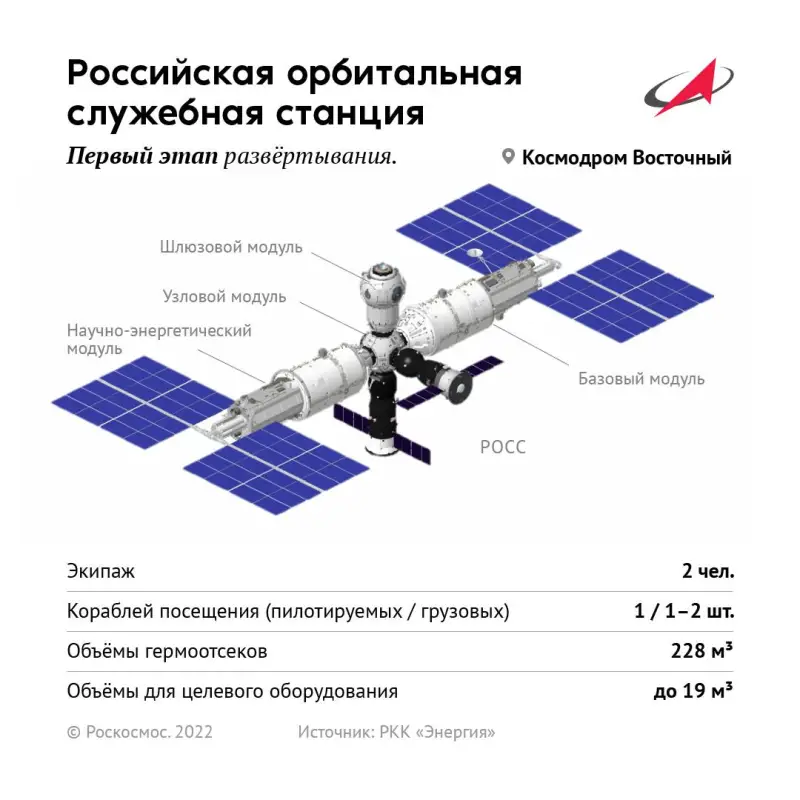Faster, higher, stronger? Sovereign orbital station ROSS

Draft design of the Russian orbital service station
Space is our everything
Roscosmos does not stand still. This cannot be denied. Of course, before plans aviation The industry with three hundred passenger airliners by 2030 is still a long way off, but the list of expectations is impressive.
One project turned out very badly - we are talking about the Luna-25 lander, which crashed on the surface of the Earth’s satellite on August 20, 2023. It’s too early to talk about the project’s fiasco. Roscosmos firmly intends to continue the development of the Luna-26 and Luna-27 spacecraft, taking into account the sad experience of its predecessor.
Work is actively underway on the Soyuz-5 rocket and its giant first-stage engine RD-171MV, which is considered the most powerful in the world. The future constellation of Sphere satellites is of utmost importance, designed to provide communications to the regions of the Far North, as well as to give impetus to the development of the Internet of Things in the country. With the assistance of Roscosmos, a project of a Russian analogue of Starlink from the Bureau 1440 office is moving forward. In August 2023, with the help of three Rassvet-1 satellites, a communication session was conducted between Moscow and operators on a mountain peak in Adygea.
By 2035, developers predict that about nine hundred communications satellites will be sent. The products are planned to be placed in low orbits at an altitude of 600 km. This will allow communication using relatively small terminals, like Starlink.
The above is not the entire selection of current new products - serious research is being carried out in deep space, but practical application in this industry is still far away.
As a result, Roscosmos works for the future, and quite actively, although not always in the way that ordinary people would like.
In the series of Roscosmos plans, people increasingly began to remember the ambitious project of a sovereign Russian orbital station. In the topic of the domestic space program, one cannot help but dwell on the special place of the International Space Station (ISS). In our crazy world, there is a complete feeling that there is some kind of parallel Universe on the ISS.
In one, we almost declare war on the United States. At the very least, we are accused of direct participation in the conflict in Ukraine. This is how Russian Foreign Minister Sergei Lavrov put it at the beginning of December 2022. In another reality, a mixed crew coexists in Earth orbit, in which two Russians - Oleg Kononenko with Nikolai Chub and the American Laurel O'Hara. As part of the SpaceX Crew-7 mission, four people also flew to the ISS, including an American, a Dane, a Japanese and a Russian Konstantin Borisov.
All the colleagues of our cosmonauts, as we see, are exclusively from unfriendly countries. Politics, of course, is a delicate matter, but the happy faces of the ISS crew against the backdrop of bellicose rhetoric, for example, by Dmitry Medvedev, are a little discouraging.
Conclusion from stories simple - in order not to tolerate enemy faces on the ISS, it was necessary to build your orbital station on time.
Russian orbital station
The cooling in Russia’s relations with its space partners began in 2014. The first to go under the knife was the ISS project, in which Russia had a significant stake. Of the 15 modules of the orbital station, six belong to the Russian segment. Considering the relatively modest costs of Roscosmos, Russia's share is allocated to a considerable amount. I remember that Dmitry Rogozin, being the Deputy Prime Minister in charge of the space industry in 2014, announced the impossibility of Russia’s continued participation in the ISS program after 2024.
The reality turned out to be completely different - at the moment, Russia has no alternative to the international station. Quitting the joint space program is necessary not only for political reasons.
Difficulties are created by the location of the Vostochny Cosmodrome, from which launching spacecraft to the ISS is fraught with risks. First of all, because of the long trajectory over the sea, which in case of an accident is fraught with danger for the crew. There is no way at all to send cargo and crews to the ISS from the Plesetsk cosmodrome - the inclination of the orbital station does not allow it.
The ISS is inevitably aging. It was not supposed to survive until 2024 at all - according to the program, the station completed work on resource development back in 2013.
Now the life of the multi-billion dollar project has been extended until 2030 and, it seems, this is the final extension. And if none of the players bothers with a replacement sooner, the only orbital station in space in six years will remain the Chinese “Heavenly Palace” (Tiangong). The Chinese comrades could not even imagine such a gift.
Roscosmos officials appear to have an ace up their sleeve. Only it costs about 600 billion dollars, and this is a preliminary price. As soon as the real work begins, the cost will inevitably increase - there is no other way.

Draft design of the Russian orbital service station
The Russian station, also called the Russian Orbital Service Station (ROSS), will fly in a polar orbit with an inclination of 97 degrees at an altitude of 372 kilometers. The orbit will allow more time to be over Russian territory - currently on the ISS this accounts for no more than 5 percent of the flight time. The new orbit will significantly reduce Roscosmos’ dependence on the Baikonur Cosmodrome, even if it is located in a friendly state.
It will be possible to fly the ROSS from both the civilian Vostochny and military Plesetsk without serious risks for the crews. The bonuses of the new station do not end there. The design of the station provides for an open modular architecture, that is, theoretically, the service life of the ROSS is not limited - each module can be replaced with a new one. As a result of such “regeneration” the entire station will be renewed. According to the authors, by 2050 at least three times.

Ballistic flight support specialist at the Rocket and Space Corporation (RSC) Energia, Nikita Chudinoy, recently announced the possibility of a promising station sending vehicles to the Moon every two weeks. The main mission of ROSS seems to be preparing domestic cosmonauts for flights beyond the Earth's orbit.
A high-latitude orbit will inevitably lead to an area of high cosmic radiation, which is as similar as possible to conditions in deep space. Now on the ISS, in this sense, everything is safe, but it limits the possibilities for experiments and research in the field of interplanetary flights.
The first module of the ROSS station, most likely a scientific and energy module, should appear in orbit as early as 2027. Then it is joined by a node, gateway, base and several highly specialized modules.
The Americans also have a project for their own space station. Lunar Orbital Platform-Gateway (LOP-G) can hardly be called an analogue of the ISS, since it will have to rotate around the Moon. The Americans should have a unique alternative to a lunar station on the surface of the satellite. From the LOP-G base they intend to launch manned missions both to the Moon itself and to Mars.
So far, in addition to the United States, Canada, the European Union and Japan have joined the project. Russia withdrew from the program in 2021. LOP-G is as beautiful technically as it is utopian in implementation.
Especially when Russian technologies and competencies were removed from it. But its goal is similar to the planned Russian station - to study as much as possible all the intricacies and dangers of interplanetary manned flights.
We are moving into a new space era. If there are no global progress, then in a few years a competition between orbital stations will unfold in space. Some will be sovereign (Russian and Chinese), and some will decide to build together with other states - we are talking about the Lunar Orbital Platform-Gateway.
On the one hand, this will allow stations to work more efficiently under national orders, on the other hand, it will inevitably be more expensive and not so technologically advanced. At the very least, the ISS did not allow participants to experiment with things prohibited in space weapons technologies.
Now the temptation to build something “like that” away from prying eyes will be difficult to overcome. And the Russians, and the Chinese, and, of course, the Americans. This is one of the most important reasons why ROSS must be built - our country has no right to lose the initiative in space.
Information